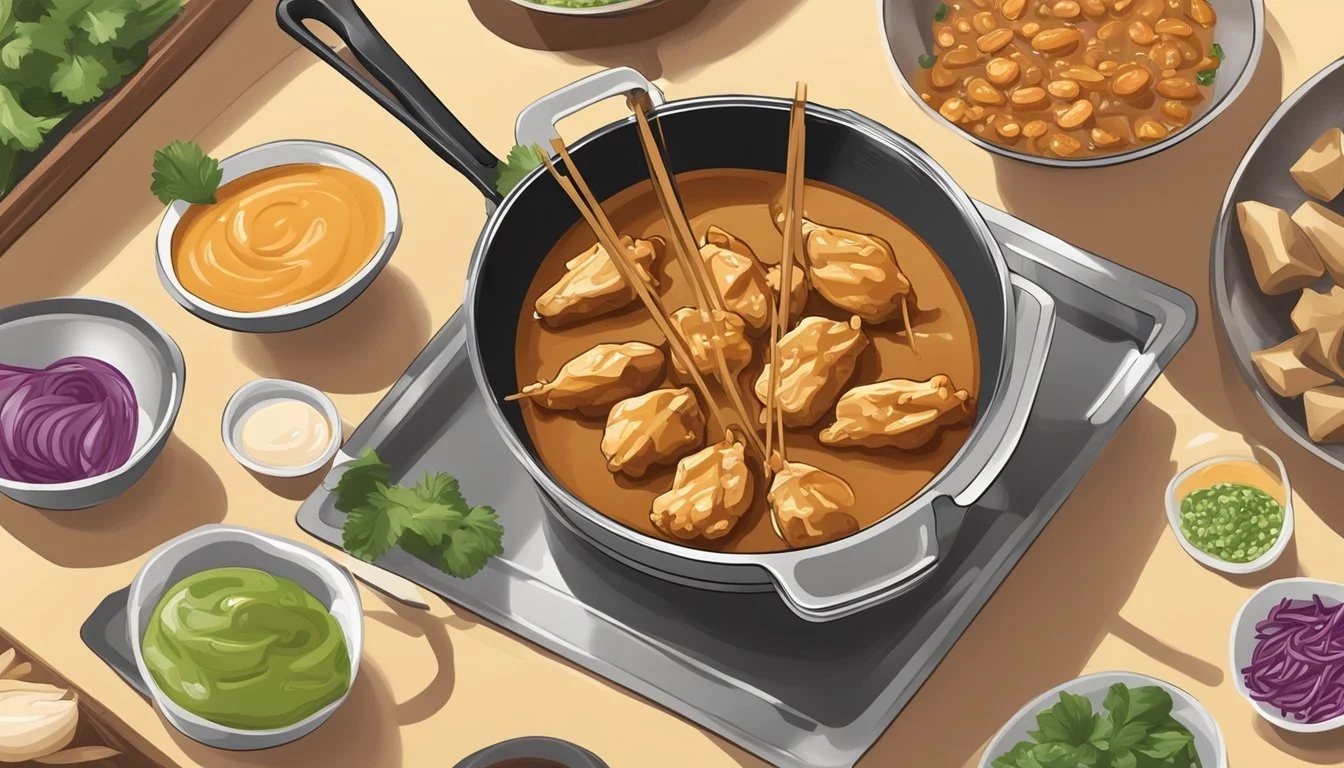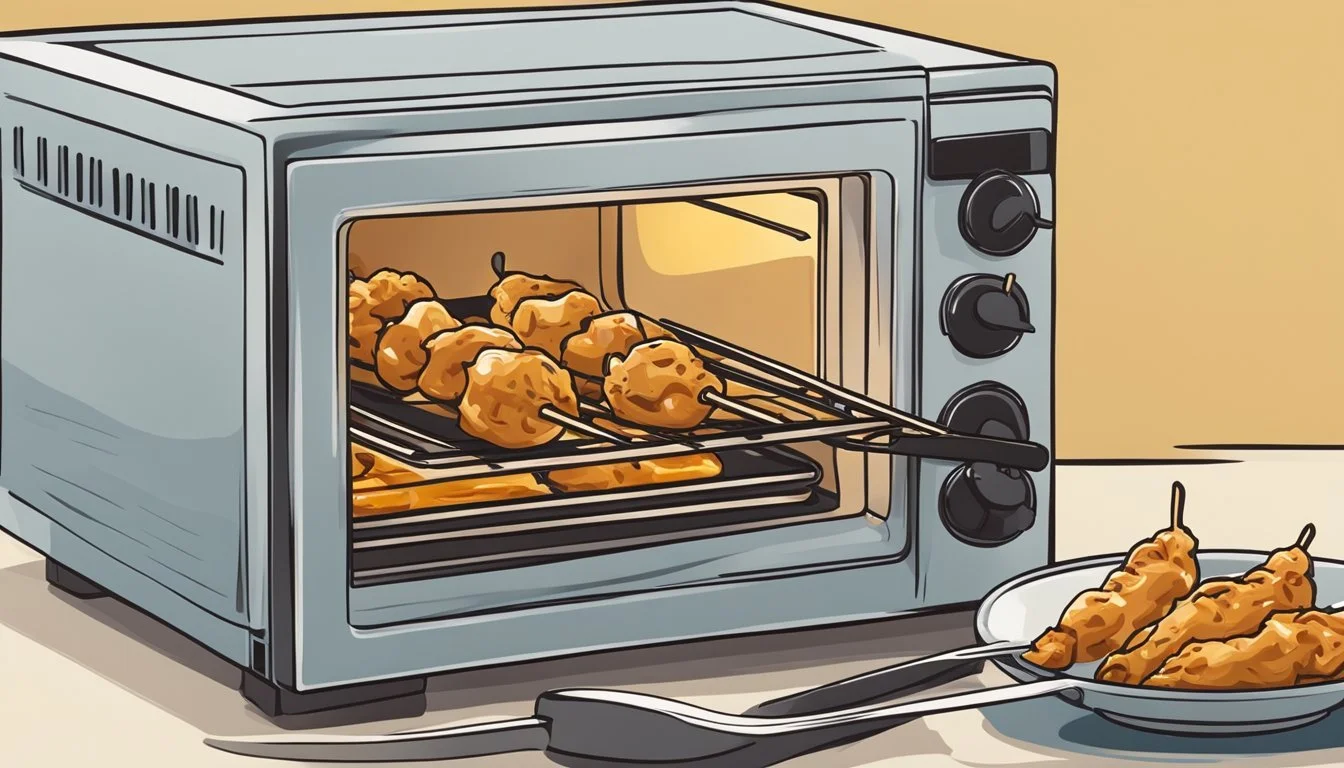Best Way to Reheat Chicken Satay
Tips for Maintaining Moisture and Sauce Texture
Chicken satay (What wine goes well with chicken satay?), a popular dish found in Thai cuisine, has won over food enthusiasts around the world with its savory skewers and the harmonious accompaniment of peanut sauce. Often served as a delectable street food, it offers a burst of authentic flavors that represent the heart of Thai cooking. Reheating chicken satay while maintaining its juicy tenderness and the creamy integrity of its peanut sauce can be a culinary challenge. The balance lies in employing gentle reheating methods that preserve moisture and enhance flavors without overcooking.
To achieve optimal results, one must consider the delicate nature of chicken satay and the subtle nuances of its accompanying sauce. The process begins with selecting the appropriate reheating technique that complements the dish's ingredients. Heat must be distributed evenly, ensuring the meat stays succulent and the peanut sauce retains its desired consistency. Whether enjoyed as a quick snack or as part of a larger meal, rekindling the essence of chicken satay's freshness is essential for an authentic taste experience.
Comparing Reheating Methods
Choosing the right reheating method for chicken satay can make a significant difference in preserving its juiciness and the consistency of the accompanying peanut sauce. Each technique has its own benefits, depending on the equipment available and the desired outcome.
Grill Reheating Technique
Grill pans provide a convenient way to recreate the charred and smoky flavor akin to a barbecue. When reheating chicken satay, one should preheat the grill pan to medium-high heat and lightly oil it to prevent sticking. Place the skewers on the grill and reheat for about 2-4 minutes on each side. It's crucial to maintain a close watch to avoid overcooking, as it can dry out the chicken.
Oven Reheating Method
An oven is an ideal method for reheating chicken satay when aiming for an evenly heated dish while retaining moisture. Preheat the oven to 350 degrees Fahrenheit. Arrange the skewers on a baking sheet, possibly over a rack to allow heat circulation. Heat for about 10-15 minutes, checking periodically until an internal temperature of 165 degrees Fahrenheit is reached.
Stovetop Reheating Approach
The stovetop method provides quick reheating and allows for better moisture control. In a suitable pan over medium heat, arrange the skewers and add a small amount of water to create steam, covering with a lid. Allow the chicken satay to heat for about 5 minutes, turning occasionally to promote even warming. This technique ensures the chicken stays moist and heats through without losing flavor.
Maintaining Juiciness in Chicken
When reheating chicken satay, the focus should be on preserving the meat's moisture and tenderness. Two key factors play a pivotal role in this: monitoring internal temperature and the effect of the marinade used prior to cooking.
Importance of Internal Temperature
The internal temperature is crucial to maintaining the juiciness of chicken satay. Whether the chicken is boneless or skinless, one should aim for a reheating temperature that brings the chicken to 165°F, as recommended by food safety guidelines. Using a meat thermometer is the best way to ensure that the chicken has reached the desired temperature without overcooking it.
Optimal reheating temperatures:
Oven: Preheat to 350°F and reheat for 10-15 minutes.
Microwave: Heat on medium power for 30-60 seconds per skewer.
To prevent drying out, the chicken should not stay in the heat source for longer than necessary. If using a microwave, the chicken satay may benefit from a wrap in damp paper towels to retain moisture.
The Role of Marinade
Marinades add flavor while also playing a significant part in keeping chicken satay tender. A good chicken satay marinade usually contains acidic components or enzymes that help in tenderizing the meat. Ingredients such as lime juice or coconut milk in the marinade assist in maintaining the moisture of the chicken.
Utilizing the marinade post-cooking:
After initial cooking, chicken can be stored in the refrigerator in some of the unused marinade to keep it moist.
Before reheating, allow the chicken to come to room temperature to ensure even heating.
The time chicken remains in the marinade also matters. Marinating too long, especially in a highly acidic mixture, can break down the proteins excessively, leading to a mushy texture. However, a well-composed marinade can protect the chicken during the cooking process.
Preserving Peanut Sauce Consistency
The key to a perfect peanut sauce lies in understanding the ingredients that influence its thickness and mastering the techniques for achieving a consistent texture.
Ingredients That Impact Thickness
Creamy Peanut Butter: The primary thickening agent in peanut sauce. Its composition of ground peanuts and oil contributes to the sauce's creamy texture.
Coconut Milk: A crucial liquid ingredient, often full-fat coconut milk is used for a rich consistency. It balances the thickness brought on by the peanut butter.
Peanuts: Chopped or whole, peanuts can alter the texture, adding crunch and affecting the density of the sauce.
Careful selection and balance of these components ensure the sauce maintains its intended consistency.
Techniques for Consistent Texture
Whisking: Utilizing a whisk is essential for merging the peanut butter with the coconut milk, achieving a smooth blend.
Stovetop Heat: Heating the sauce over medium-low heat helps the ingredients combine cohesively. Steady heat allows the sauce to thicken without becoming overly dense.
Consistency in texture is maintained through continuous whisking and controlled heat, preventing the sauce from separating or becoming uneven.
Preparation Prior to Reheating
Ensuring that chicken satay and its accompanying peanut sauce are stored properly is crucial for maintaining their quality during reheating.
Proper Chicken Satay Storage
One should store chicken satay in airtight containers or wrap it securely with cling film to prevent exposure to air and moisture, which can lead to dryness and spoilage. The chicken satay must be placed in the refrigerator within two hours of cooking to keep it safe for consumption. It is best to lay the skewers flat without overlapping to preserve the meat's texture and moisture.
Let chicken satay cool to room temperature.
Transfer to airtight containers or wrap with cling film.
Place in the coldest part of the refrigerator.
Pre-Reheating Peanut Sauce Tips
Prior to reheating, the peanut sauce should be reviewed for consistency. If it has thickened in the fridge, one might consider adding a small amount of water or broth to regain the desired consistency. It's also recommended to store the peanut sauce separately from the chicken to prevent the satay from becoming soggy and to preserve the sauce’s flavor.
Sauce storage:
Store peanut dipping sauce in a separate container.
Secure the lid tightly to prevent contamination.
Keep in the fridge, away from strong-smelling foods to maintain its original taste.
Accompaniments and Pairings
When serving chicken satay, one must consider that the juiciness of the meat and the savory notes of the peanut sauce are complemented and balanced by certain side dishes and beverages. Selecting the right accompaniments can elevate the meal significantly.
Side Dishes to Serve
Chicken satay is often paired with side dishes that both compliment and contrast its rich flavors and textures. Below are optimal choices:
Rice Varieties:
Coconut Rice: Infused with coconut milk, this aromatic side adds a creamy texture that harmonizes with the satay's peanut sauce.
Jasmine Rice: Light and fluffy, it provides a subtle fragrance that doesn't overpower the main dish.
Noodles:
Spicy Peanut Noodles: Mirroring the flavors in the satay sauce, these can add a kick with their spice.
Salads:
Asian Slaw: A crunchy and tangy slaw can balance the richness of the chicken.
Cucumber Salad: It has a refreshing quality that cleanses the palate between bites of satay.
Vegetables:
Grilled Vegetables: (What wine goes well with grilled vegetables?) Opt for a medley of vegetables like broccolini or bell peppers to add color and a slight char to the meal.
Beverage Pairings
Choosing the right beverages to go with chicken satay will depend on whether one is looking to refresh, cleanse, or complement the palate:
Non-Alcoholic:
Lime Wedges: Squeezing fresh lime juice over chicken satay or into a glass of water can enhance flavors with its citrus note.
Coconut Milk-based Drinks: They can echo the dish's use of coconut, creating a cohesive tasting experience.
Alcoholic:
Beer: A light, crisp beer can cut through the richness while cleansing the palate.
Wine: Off-dry Riesling or a light Rosé pairs well with the savory peanut sauce without overwhelming the taste of the satay.
Each pairing is chosen to match the intensity and flavors of chicken satay, ensuring a balanced and enjoyable meal.
Nutritional Information
When reheating chicken satay, the nutritional content is an important consideration for maintaining a healthy diet. Chicken satay typically consists of grilled chicken served with a flavorful peanut sauce. The chicken provides a valuable source of protein, which is crucial for muscle repair and growth.
Chicken:
Protein: High-quality protein source.
Calories: Moderate, depending on serving size and preparation.
Fats: Usually low unless cooked with additional oil.
Carbohydrates: Minimal, unless breaded or marinated with sugary sauces.
Peanut Sauce:
Calories: High, due to the presence of peanuts and possible added sugars.
Healthy fats: Monounsaturated and polyunsaturated fats, beneficial for heart health.
Protein: Additional protein from peanuts.
Vitamins and Minerals: Contains vitamins E, B6, magnesium, and potassium.
The nutritional value can vary depending on ingredients used in both chicken and peanut sauce. To promote healthy eating, sauces should be made with controlled amounts of sugar and sodium.
Macronutrients Breakdown per Typical Serving:
Nutrient Approximate Amount Calories 250-350 kcal Protein 20-30 g Carbohydrates 10-15 g Fats 15-20 g
It is advisable for individuals to tailor their portion sizes and condiment usage according to their specific dietary needs and goals..Health-conscious diners should consider using a homemade peanut sauce to manage additives and preservatives often found in commercial options, aiming for a balance between flavor and nutrition.
Recipe Variations
When customizing Chicken Satay and its accompanying peanut sauce, cooks can explore a range of marinades and sauce variations to suit different dietary needs and flavor preferences.
Alternative Satay Marinades
The marinade is crucial in imparting Chicken Satay with its distinctive zest. Here are variations to consider:
Gluten-Free Option: Replace traditional soy sauce with tamari or coconut aminos.
Vegan Options: For a plant-based twist, marinate tofu or seitan (What wine goes well with seitan?) in place of chicken.
Flavor Boost: Add extra spices such as turmeric to the marinade for its earthy flavor and potential health benefits.
Peanut Sauce Variations
The peanut sauce can also be tailored:
Natural Peanut Butter: Use natural peanut butter as the base for a healthier option.
Heat Adjustment: Modify the spiciness to taste by increasing or decreasing chili sauce.
Consistency Control: Thin the sauce with water or thicken it with more peanut butter until the desired consistency is reached.
By experimenting with these variants, one can craft a dish that caters to various palates and dietary restrictions while maintaining the essence of Chicken Satay.
Serving Suggestions
When ready to serve reheated chicken satay, presentation and garnishing are crucial to recreating the appeal of this appetizer. A mindful arrangement on the plate and the addition of fresh garnishes can enhance both the flavors and visual allure of the dish.
Presentation Tips
The best presentation for chicken satay is to serve it on a warm plate, ensuring the satay skewers are neatly lined up or arranged in a fan shape for visual appeal. Use serving dishes that contrast the color of the satay to make it stand out. For example, white or light-colored plates provide an excellent backdrop to the rich brown hues of the grilled chicken.
One can also serve chicken satay as part of a larger appetizer platter. In such cases, ensure each component is clearly separated. The inclusion of small bowls for peanut sauce allows for easy dipping and prevents the rest of the food on the plate from becoming soggy.
Garnishing Ideas
To finalize the presentation, add a sprinkling of chopped fresh cilantro and crushed peanuts over the chicken satay for an extra layer of texture and flavor. If desiring a pop of color, consider garnishing with thin slices of red bell pepper or carrot. This not only adds visual interest but introduces a subtle crunch, balancing the satay's juiciness.
A sprig of cilantro can also be placed on the side of the plate for an elegant touch. It's important to use these garnishes sparingly to complement, not overpower, the main flavors of the chicken and peanut sauce.
Common Mistakes to Avoid
When reheating chicken satay, it's crucial to retain the juiciness of the marinated chicken and the consistency of the peanut sauce. Paying attention to reheating methods is vital to avoid a dry or unevenly cooked outcome.
Overheating Pitfalls
One should never reheat chicken satay on excessively high settings. High temperatures can dry out the marinated chicken, strip it of its flavors, and toughen the meat. To avoid this:
Microwave: Heat on medium power for 30-60 seconds, checking frequently.
Oven: Bake at no more than 350°F (175°C), and closely monitor doneness.
Sauce Separation Concerns
The peanut sauce accompanying chicken satay is prone to separation if not handled carefully during reheating. Maintaining the creamy consistency of the sauce is paramount. Here are specific tips:
Stirring: Stir the sauce gently to maintain uniformity.
Heating: Warm the sauce on low heat, avoiding boiling, to prevent breakdown.
Combination: If the sauce is reheated with the chicken, ensure thorough mixing for an even distribution of heat without overheating.
FAQs on Reheating Chicken Satay
To ensure the juiciness of chicken satay and consistency of peanut sauce when reheating, one must follow specific methods and pay attention to detail. The subsections below address common concerns regarding texture and sauce quality.
Questions on Texture Maintenance
Achieving optimal texture in reheated chicken satay boils down to careful temperature control and reheating method selection.
Q: How can one maintain the juiciness of chicken satay when reheating?
A: Reheat in an oven or stovetop. For the oven, preheat to 350°F and heat for 5-10 minutes. On a stovetop, use a non-stick skillet over medium heat.
Q: Can chicken satay be microwaved without drying out?
A: Yes, but wrap the satay in damp paper towels and microwave on high for 30-60 seconds per skewer. This helps retain moisture.
Inquiries About Peanut Sauce
Retaining the desired consistency of peanut sauce after reheating is as crucial as the texture of the meat itself.
Q: What is the best way to reheat peanut sauce to preserve its thickness?
A: Gently reheat the sauce over low heat on the stovetop, stirring constantly to avoid separation.
Q: How should leftover peanut sauce be stored?
A: Store in an airtight container in the refrigerator and consume within two to three days for best quality.
Conclusion
Reheating chicken satay correctly helps maintain its juiciness and the integrity of the peanut sauce. Through various methods tried and analyzed, the most effective techniques have become clear.
One should gently reheat the grilled chicken satay skewers to prevent them from drying out. Utilizing the oven with a covering of foil helps retain moisture and evenly warms the satay. The internal temperature should reach 165°F, crucial for both safety and quality. The microwave method, while quicker, requires careful monitoring to prevent rubbery texture. For best results:
Use medium power
Heat in short intervals of 30-60 seconds
Turn skewers halfway through to ensure even heating
To preserve the peanut sauce's consistency, it is best reheated separately, if possible, stirring occasionally to keep the sauce smooth.
Adhering to these best practices ensures a flavorful and safe eating experience. They should be diligently followed each time one wishes to enjoy leftover chicken satay.
Lastly, for those who prioritize optimal texture, using a moist heat method such as steaming or a covered pan on the stove can offer a balance between reheating and moisture retention. The choice of method ultimately depends on one's personal preference and kitchen equipment availability.









